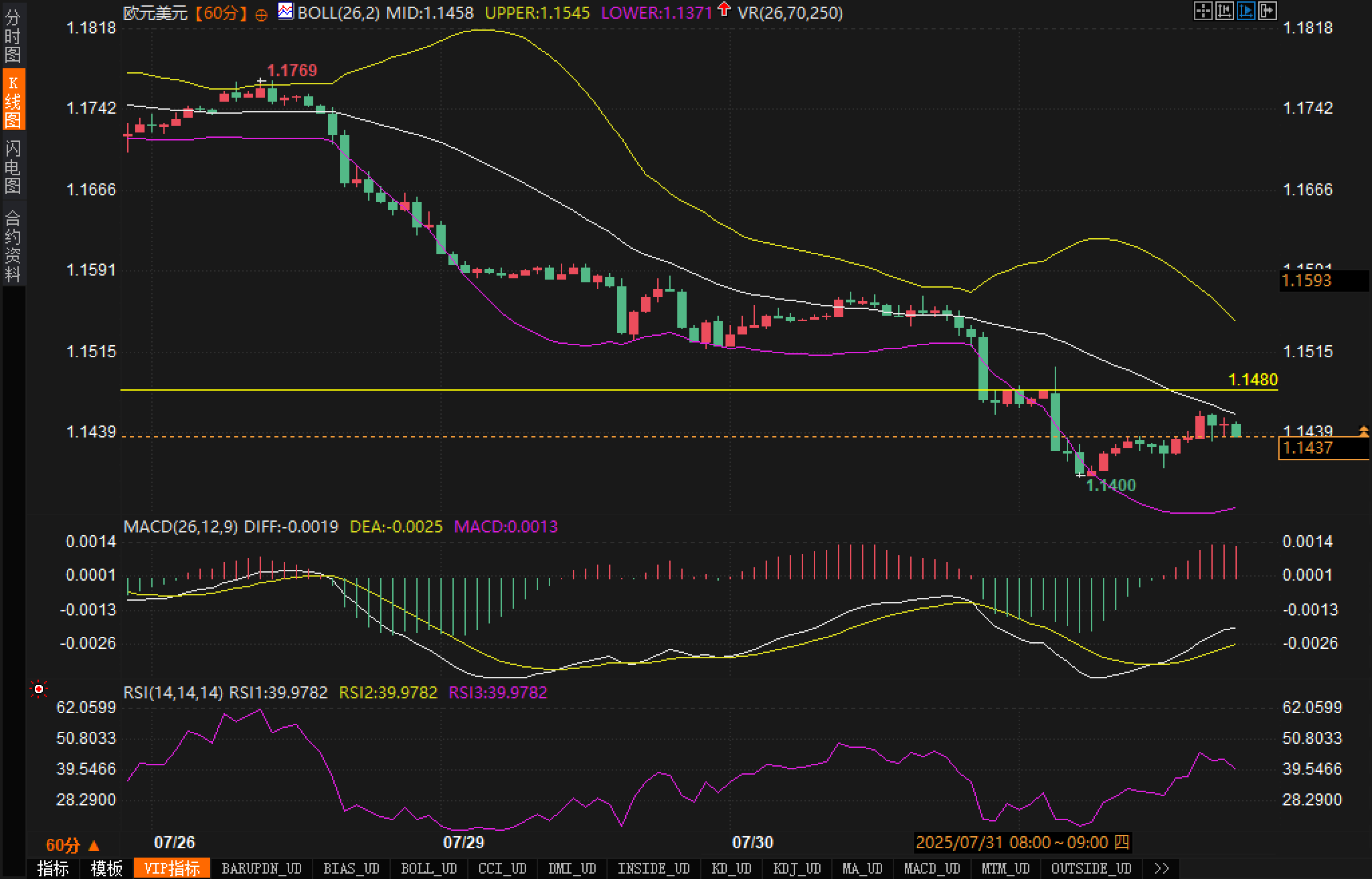The downward trend remains, are euro bulls waiting for a good opportunity to counterattack in September?
2025-07-31 17:48:02

Fundamentals:
The Eurozone's latest second-quarter GDP data showed a 0.1% quarter-over-quarter growth. While better than the previously expected zero growth, the 0.6% decline from the previous reading suggests a significant slowdown in economic momentum. Markets had initially hoped the Eurozone economy would recover from the tariff disruptions. However, weak growth, coupled with declining inflation, has heightened expectations of a dovish shift in the ECB's monetary policy. While the market is currently pricing in only a 15 basis point rate cut this year, further scope remains as economic data continues to weaken.
In contrast, data from the United States showed strong recovery momentum. Second-quarter GDP grew at an annualized rate of 3.0%, significantly exceeding market expectations of 2.4%. Meanwhile, the ADP employment report showed 104,000 new private sector jobs, also exceeding market expectations. Against this backdrop, the Federal Reserve maintained its policy rate at 4.25%-4.50% as expected. Despite two officials favoring a rate cut, Chairman Powell did not explicitly signal a September rate cut during his press conference, emphasizing that the "path of inflation remains uncertain," reinforcing the market's pricing in higher and longer-term interest rates.
In terms of fundamental comparison, the economic slowdown in the eurozone contrasts sharply with the resilience of the US economy, driving the US dollar index to remain high and the euro/dollar exchange rate to continue to be under pressure.
Technical aspects:
Looking at the hourly candlestick chart, EUR/USD has accelerated its decline since its high of 1.1769, showing a clear downtrend. The exchange rate continues to trade between the middle and lower Bollinger Bands, with the short- and medium-term trend lines diverging downward, indicating that the bearish trend has not yet reversed.

The exchange rate has struggled to rebound from the previous support level of 1.1480 and is currently being held down by the middle Bollinger Band, turning 1.1480 into a clear resistance level. Analysts believe that if it fails to hold this level, it could retest the support area of 1.1400. A break below 1.1400 could open the way for a test of the 1.1300 range.
The MACD indicator shows that the current DIFF and DEA are still in negative territory, indicating that the current rebound is a weak technical rebound. The RSI indicator is currently at 39.97, in a weak range. There are no signs of oversold recovery and no clear divergence support. The price still has the risk of further decline due to the inertia of the short position.
Market sentiment observation:
Market sentiment is clearly leaning toward defense. After the exchange rate fell from its high of 1.1769, the market failed to establish a valid bullish resistance, and the rebound momentum was weak, indicating that the market is still dominated by bears. With the US dollar continuing to benefit from improving economic data and the Federal Reserve's hawkish stance, the overall market still has a "trend-following" trading mentality.
Furthermore, from the perspective of the options market, rising implied volatility in short-term options suggests high market expectations for price fluctuations in the coming days, reflecting traders' heightened vigilance against downside risks. Meanwhile, from a positioning perspective, despite significant short-covering of US dollar positions last week, overall market positioning is not extremely skewed, leaving room for further US dollar bullish momentum.
Market outlook:
Short-term Outlook: Analysts believe that if the US PCE price index data for June, released this evening, maintains a moderate upward trend, coupled with the July non-farm payroll data to be released on Friday, which further confirms the economic resilience, the US dollar is expected to continue to gain support and the exchange rate may continue to fluctuate downward. Focus on the effectiveness of the 1.1400 round-number support level. If it fails, the 1.1300 support range will be further tested.
Medium-term Outlook: Analysts believe that continued weakness in Eurozone data and cooling inflation expectations in the coming weeks could prompt the European Central Bank to send a more dovish signal at its September meeting, intensifying systemic depreciation pressure on the euro. However, seasonal and technical trends suggest that August tends to see more volatile markets, and the 1.1300 area may form a temporary bottom.
In the bullish scenario: Analysts believe that if the US data falls short of expectations and the market's expectations for the ECB to remain on hold increase, the exchange rate is expected to rebound in the short term. Focus will be on whether it can break through the 1.1480 pressure level and further test the resistance above 1.1550.
In the bearish scenario: Analysts believe that if the non-farm payroll data is strong and PCE inflation rises instead of falling, the US dollar may usher in another round of buying climax, and the exchange rate will accelerate its decline to 1.1300, and there is even potential for it to fall to 1.1200.
- Risk Warning and Disclaimer
- The market involves risk, and trading may not be suitable for all investors. This article is for reference only and does not constitute personal investment advice, nor does it take into account certain users’ specific investment objectives, financial situation, or other needs. Any investment decisions made based on this information are at your own risk.





















